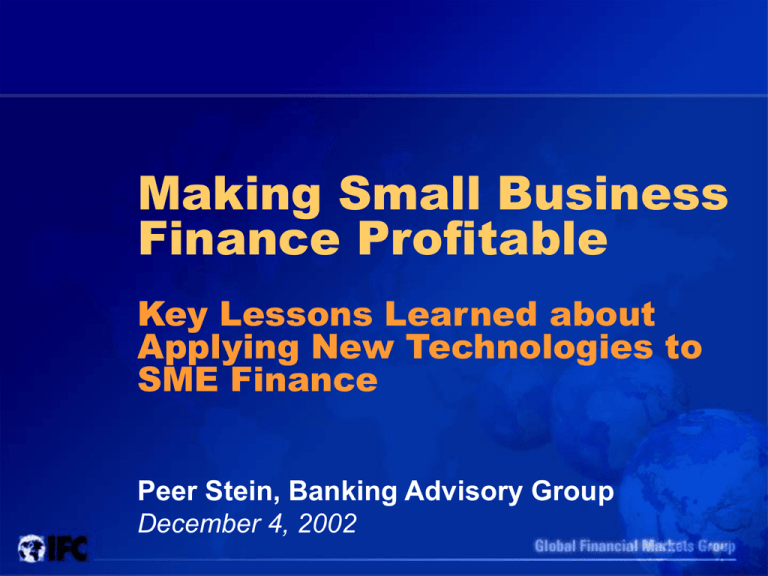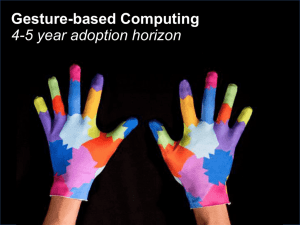438 kb PowerPoint presentation
advertisement

Making Small Business Finance Profitable Key Lessons Learned about Applying New Technologies to SME Finance Peer Stein, Banking Advisory Group December 4, 2002 Shifting the Productivity Frontier Productivity Frontier (Future state of Best Practice) How? Generating Growth: Through profitable marketing strategies Improving Asset Quality: Through enhanced risk management Lower unit costs per transaction or service Limited services to limited number of customers UNPROFITABLE Broader service offerings & higher asset quality Increasing Operating Efficiency: Through technological innovation Developing successful small business finance operations – A Bottom Up Approach Growth 6. Systems / IT 5. Organization 4. Delivery Channels 3. Risk Management / Analytics 2. Products/Services Operating Efficiency 1. Market Research Asset Quality Profitability = (New Business + Client Retention) - Cost 6. Systems / IT 5. Organization 4. Delivery Channels 3. Risk Management / Analytics 2. Products/Services 1. Market Research 1. Market Research Assess data sources & reliability – Information and credit reports both for consumers and for businesses (if possible – cross-referenced) – Default information, if available (by industries, companies) Carry out secondary market research – Segmentation (size & industries) – Regional focus and characteristics – Competitive analysis (other sources, products, terms & conditions) Conduct primary market research and focus groups – Stage 1: Assessing customer preferences and profitability potential – Stage 2: Testing specific product/services designs Segmentation capabilities of own clients and market. 6. Systems / IT 5. Organization 4. Delivery Channels 3. Risk Management / Analytics 2. Products/Services 1. Market Research 2. Product/Services • Domestic payments • International payments • Check processing • Secured loans • Unsecured Loans Payments Credit Savings • Credit Cards • Checking accounts • Savings accounts • Money market accounts Value-added • Payroll services • Accounting/tax support • Insurance • Information & tools Maximize client retention and profitability by offering product packages as well as cross- and up-selling. 6. Systems / IT 5. Organization 4. Delivery Channels 3. Risk Management / Analytics 2. Products/Services 1. Market Research 2. Product/Services – Credit examples #1: Small Business Loan based on Wells Fargo Model – – – – Processes based on portfolio approach: standardized loan origination through credit application scoring, rapid response time, low-maintenance account access through electronic & telephone banking Average outstanding loan size in the US case: US$15,000 Target market: Sole proprietorships and very small businesses Requires suitable external data availability to build solid scoring systems 6. Systems / IT 5. Organization 4. Delivery Channels 3. Risk Management / Analytics 2. Products/Services 1. Market Research 2. Product/Services – Credit examples #2: Receivables Financing Loan based on SME Loan – – – – Automated processes yet very client-driven: standardized loan origination using a combination of application scoring and basic credit review, real-time credit risk management on the basis of an automated monitoring of sales, cash & receivables of the clients Average outstanding loan amount in HK case: US$100,000 Target market: larger small and the lower end of mid-sized companies Requires suitable legal framework for security arrangements and basic internet penetration among SMEs 6. Systems / IT 5. Organization 4. Delivery Channels 3. Risk Management / Analytics 2. Products/Services 1. Market Research 3. Risk Management / Analytics Pre-selection and Marketing – Review performance by sales and origination channel (e.g. target marketing vs. unsolicited applications) – Define pre-selection strategies for own clients (crossselling), clients of clients, and market segments Underwriting – Review current performance of small business clients in both retail portfolios and commercial portfolios – Leverage credit scoring experience of consumer credit underwriting (models, application processing, reporting) Portfolio Management and Collections – Review current performance of collections – Leverage retail experience in collections (defined stages, collection scoring, call center) Data capture & management, analytical skills and monitoring. Importance Attached to Credit Reporting: Survey of Latin American Banks 35 Number of Firms 30 25 20 15 10 5 0 Collateral Financial Standing Of The Borrower Borrower's History With the Bank Information from a credit registry is more important Information from a credit registry is less important Value Of Data for SME Lending HIGH BUSINESS VALUE PERSONAL LOW SMALL SIZE OF COMPANY LARGE 6. Systems / IT 5. Organization 4. Delivery Channels 3. Risk Management / Analytics 2. Products/Services 1. Market Research 4. Delivery Channels Review delivery channels options – Existing channel mix & utilization – Level of automation Adapt and develop delivery channels – Keep it simple – 24/7 – Branch – Business Bankers/Agents – ATM – Call center – Electronic Banking – Mobile Banking? Cost efficiency, differentiation in the market and client satisfaction. 6. Systems / IT 5. Organization 4. Delivery Channels 3. Risk Management / Analytics 2. Products/Services 1. Market Research 5. Organization Review current organizational set-up – Current market and product focus – Sales / Credit / Collections Allign organizational requirements – Separate organizational responsibilities for SME Finance (rather part of retail than of commercial banking) – Combined factory and sales approach – Centralized processing of credit applications – Clear responsibilities for collections – Clear responsibilities and incentives for deposit raising and cross-sales (including personal financing needs of the owner) Clear responsibilities and clear processes. 6. Systems / IT 5. Organization 4. Delivery Channels 3. Risk Management / Analytics 2. Products/Services 1. Market Research 6. IT / Systems Review current systems – Client-driven vs. product-driven – Reporting and data management capabilities – Delivery channel support Adapt systems development – Towards Customer Relationship Management (CRM) capabilities – Towards maximum data availability – Towards multi-channel management Be able to use information – record / report / analyze.







